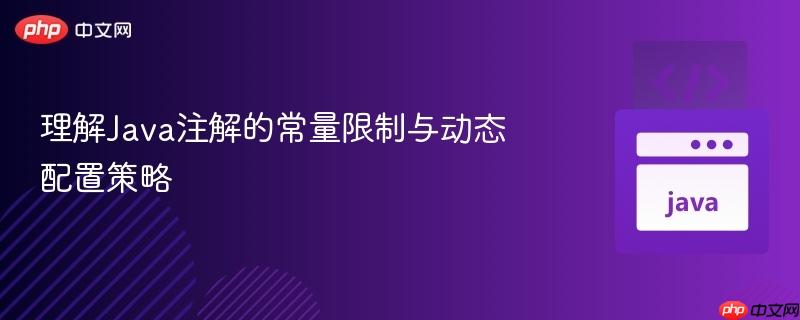
java注解的参数必须是编译时常量,因此无法直接从`application.properties`等外部配置文件动态传入值。本文将深入探讨java注解的这一设计限制,并提供多种替代方案,如使用spring的`@value`注解、条件注解或aop等,以实现基于外部配置的动态行为控制,从而满足业务需求。
在Java应用开发中,自定义注解为我们提供了一种强大的元数据标记机制,常用于简化配置、实现横切关注点或提供编译时/运行时信息。例如,我们可能定义一个@PartyCacheable注解来标记需要进行缓存的类或方法,并希望通过注解的enable属性来控制缓存的启用与禁用。一个常见的需求是,这个enable属性的值能够根据外部配置文件(如Spring Boot的application.properties)动态调整,而非硬编码。然而,尝试直接将配置文件中的属性值绑定到注解参数上,如@PartyCacheable(enable = ${party.cache.enable}),是不可行的。
Java语言规范明确规定,注解的元素(即参数)必须是以下类型之一:
更重要的是,这些注解元素的值必须是编译时常量表达式。这意味着它们的值在编译时就必须确定,不能是运行时才能确定的变量或表达式。
application.properties文件中的值是在应用程序启动时(即运行时)加载和解析的。因此,这些值不符合Java注解参数必须是编译时常量的要求。试图将运行时属性值直接赋给注解参数,会导致编译错误。
立即学习“Java免费学习笔记(深入)”;
虽然不能直接将动态属性值传递给注解参数,但我们可以通过其他编程模式和Spring框架提供的机制来间接实现基于外部配置的动态行为控制。
最直接且常用的方法是将配置属性值注入到Spring管理的Bean中,然后在业务逻辑中根据注入的值进行判断。
示例:
定义配置属性: 在application.properties中定义缓存启用状态:
party.cache.enable=true
修改业务类: 在PartyProcessing类中,注入party.cache.enable属性,并在业务逻辑中根据此值决定是否执行缓存相关操作。
import org.springframework.beans.factory.annotation.Value;
import org.springframework.stereotype.Component;
// 移除 @PartyCacheable 注解,或者仅保留其作为标记,不依赖其参数
@Component
public class PartyProcessing {
@Value("${party.cache.enable:false}") // 注入属性,提供默认值
private boolean cacheEnabled;
public void processPartyData() {
if (cacheEnabled) {
System.out.println("Caching is enabled. Performing cache-related operations for party data.");
// 执行缓存逻辑
} else {
System.out.println("Caching is disabled. Processing party data directly.");
// 执行非缓存逻辑
}
// ... 其他业务逻辑
}
}优点: 简单直观,适用于控制类内部的特定行为。
如果你的目标是根据某个属性值来决定是否完全加载或启用某个Bean、组件或配置类,Spring Boot的条件注解(如@ConditionalOnProperty)是理想的选择。
示例:
定义配置属性:
party.cache.enable=true
创建条件化的Bean或配置: 你可以创建一个专门的缓存配置类,并使用@ConditionalOnProperty来控制其是否生效。
import org.springframework.boot.autoconfigure.condition.ConditionalOnProperty;
import org.springframework.context.annotation.Bean;
import org.springframework.context.annotation.Configuration;
@Configuration
@ConditionalOnProperty(
prefix = "party.cache",
name = "enable",
havingValue = "true",
matchIfMissing = false // 如果属性不存在,则不匹配
)
public class PartyCachingConfiguration {
@Bean
public PartyCacheService partyCacheService() {
System.out.println("PartyCacheService bean is created because party.cache.enable=true.");
return new PartyCacheService(); // 假设这是一个缓存服务
}
}
// 假设的缓存服务类
class PartyCacheService {
public void cacheData(String data) {
System.out.println("Caching data: " + data);
}
}在这种情况下,如果party.cache.enable属性不是true,PartyCachingConfiguration类及其内部定义的partyCacheService Bean将不会被加载到Spring上下文中。你的PartyProcessing类可以注入PartyCacheService,但如果服务不存在,则需要处理其为空的情况,或者通过@Autowired(required = false)来避免启动失败。
优点: 能够根据配置属性动态地启用或禁用整个组件或配置模块,实现更粗粒度的控制。
如果@PartyCacheable注解的初衷是为了标记一个需要应用横切关注点(如缓存、日志、事务)的方法或类,那么结合AOP(面向切面编程)是实现动态控制的强大方式。你可以在切面中注入配置属性,并根据这些属性决定是否执行切面逻辑。
示例:
自定义注解(保持不变):
import java.lang.annotation.ElementType;
import java.lang.annotation.Retention;
import java.lang.annotation.RetentionPolicy;
import java.lang.annotation.Target;
@Retention(RetentionPolicy.RUNTIME)
@Target(ElementType.TYPE) // 或 ElementType.METHOD,取决于你的设计
public @interface PartyCacheable {
// 这里的 enable 属性依然是常量,但在切面中可以结合外部配置来决定是否使用它
boolean enable() default true; // 默认值可以设置为true,表示默认启用
}业务类(使用注解标记):
import org.springframework.stereotype.Component;
@Component
@PartyCacheable(enable = true) // 这里的 enable 仍然是编译时常量,但切面会动态决定
public class PartyProcessing {
public void fetchPartyDetails(String partyId) {
System.out.println("Fetching details for party: " + partyId);
// 实际的业务逻辑
}
}创建切面: 在切面中注入party.cache.enable属性,并根据其值决定是否执行缓存逻辑。
import org.aspectj.lang.ProceedingJoinPoint;
import org.aspectj.lang.annotation.Around;
import org.aspectj.lang.annotation.Aspect;
import org.springframework.beans.factory.annotation.Value;
import org.springframework.stereotype.Component;
@Aspect
@Component
public class PartyCacheAspect {
@Value("${party.cache.enable:false}") // 注入外部配置属性
private boolean globalCacheEnabled;
@Around("@within(partyCacheable) || @annotation(partyCacheable)")
public Object applyPartyCaching(ProceedingJoinPoint joinPoint, PartyCacheable partyCacheable) throws Throwable {
// 首先检查全局配置是否启用缓存
if (!globalCacheEnabled) {
System.out.println("Global caching is disabled. Skipping cache for " + joinPoint.getSignature().toShortString());
return joinPoint.proceed(); // 不执行缓存逻辑,直接执行原方法
}
// 如果全局缓存启用,可以进一步考虑注解本身的 enable 属性
// 注意:partyCacheable.enable() 仍然是编译时常量,但可以在此作为第二层判断
if (!partyCacheable.enable()) {
System.out.println("Annotation explicitly disabled caching for " + joinPoint.getSignature().toShortString());
return joinPoint.proceed();
}
// 缓存已启用,执行缓存逻辑
System.out.println("Applying caching logic for " + joinPoint.getSignature().toShortString());
// 实际的缓存查询/存储逻辑
Object result = joinPoint.proceed(); // 执行原方法
System.out.println("Caching result for " + joinPoint.getSignature().toShortString());
return result;
}
}优点: 将横切关注点与业务逻辑解耦,且切面内部可以灵活地注入各种配置,实现复杂的动态控制逻辑。这是实现类似Spring @Cacheable 行为的常用模式。
尽管Java注解的参数必须是编译时常量,无法直接从外部配置文件动态传入值,但这并不意味着我们无法实现基于外部配置的动态行为。通过Spring框架提供的@Value注解进行属性注入、@ConditionalOnProperty进行条件化加载,以及结合AOP实现横切关注点的动态控制,我们能够优雅且灵活地满足各种动态配置需求。理解这些替代方案并根据具体场景选择最合适的方法,是构建可维护和可扩展Java应用的关键。
以上就是理解Java注解的常量限制与动态配置策略的详细内容,更多请关注php中文网其它相关文章!

每个人都需要一台速度更快、更稳定的 PC。随着时间的推移,垃圾文件、旧注册表数据和不必要的后台进程会占用资源并降低性能。幸运的是,许多工具可以让 Windows 保持平稳运行。

Copyright 2014-2025 https://www.php.cn/ All Rights Reserved | php.cn | 湘ICP备2023035733号